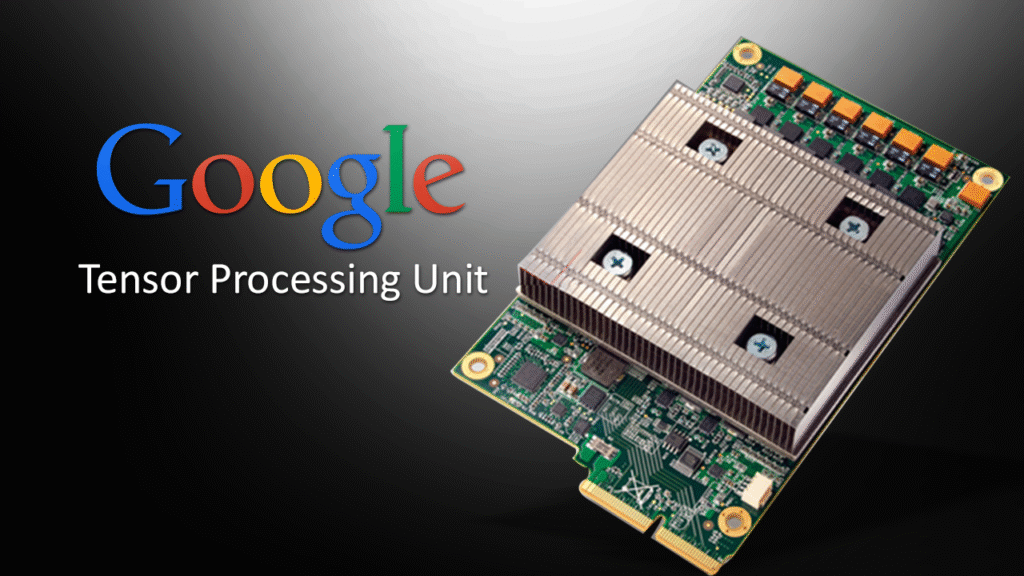
Status: Final Blueprint
Author: Shahab Al Yamin Chawdhury
Organization: Principal Architect & Consultant Group
Research Date: October 16, 2023
Location: Dhaka, Bangladesh
Version: 1.0
Part I: Understanding the TPU
The Tensor Processing Unit (TPU) is a custom-built Application-Specific Integrated Circuit (ASIC) developed by Google to accelerate AI and machine learning workloads. Its creation was driven by the unsustainable computational and energy demands of running deep neural networks on general-purpose hardware like CPUs and GPUs.
Core Principles:
- Domain-Specific Architecture: TPUs are designed exclusively for neural network computations, eliminating hardware components not relevant to AI. This specialization maximizes performance and power efficiency for targeted workloads.
- Systolic Arrays: The heart of the TPU is the Matrix Multiply Unit (MXU), a systolic array that processes massive matrix calculations with extreme efficiency. Data flows through a grid of processing elements, maximizing data reuse and minimizing energy-intensive memory access.
- Hardware-Software Co-Design: TPUs rely on the XLA (Accelerated Linear Algebra) compiler, which optimizes computation graphs from frameworks like TensorFlow, JAX, and PyTorch into efficient machine code, enabling the TPU’s unique architectural advantages.
Part II: A Generational Deep Dive
The evolution of the TPU reflects the changing demands of the AI landscape, moving from a single inference accelerator to a planetary-scale, reconfigurable supercomputer.
| Generation | Year | Primary Improvement & Focus |
| TPUv1 | 2015 | Inference Acceleration: Introduced the systolic array for 8-bit integer math, delivering 15-30x higher performance than contemporary CPUs/GPUs for inference. |
| TPUv2/v3 | 2017-18 | Training at Scale: Added floating-point (bfloat16) support, High-Bandwidth Memory (HBM), and the Inter-Chip Interconnect (ICI) to create “TPU Pods” for large-scale training. |
| TPUv4 | 2021 | Exascale & Reliability: Introduced Optical Circuit Switches (OCS) and a 3D torus interconnect, enabling exascale performance with enhanced fault tolerance and scheduling flexibility for massive models. |
| TPUv5 (v5e/v5p) | 2023 | Efficiency & Peak Performance: A strategic split between the cost-efficient v5e for mainstream adoption and the high-performance v5p for the most demanding AI tasks. |
| Trillium (v6e) | 2024 | Training Specialization: Delivers a 4.7x leap in compute performance over v5e, optimized for training the next generation of foundation models with superior performance-per-watt. |
| Ironwood (v7) | 2025 | Inference Specialization: Purpose-built for the “age of inference,” featuring massive HBM capacity (192 GB) and extreme power efficiency for running large generative models at scale. |
Part III: Performance and Competitive Landscape
Rigorous benchmarking is essential to understanding an accelerator’s true value beyond theoretical specifications.
- MLPerf Benchmarks: As the industry standard, MLPerf results consistently show TPUs setting records in large-scale training, demonstrating strong scaling efficiency and superior performance-per-dollar on key workloads like Large Language Models.
- TPU vs. GPU Comparison:
- Architecture: TPUs use specialized systolic arrays for matrix math, while GPUs use thousands of more general-purpose CUDA cores. This makes TPUs highly efficient for AI but less flexible than GPUs.
- Total Cost of Ownership (TCO): For large-scale AI workloads within the Google Cloud ecosystem, TPUs often provide a lower TCO due to superior performance-per-watt and performance-per-dollar. However, the broader flexibility, mature software stack (CUDA), and multi-cloud availability of NVIDIA GPUs can present a lower TCO for enterprises with diverse needs or a multi-cloud strategy.
Part IV: The Enterprise TPU Platform
TPUs are deeply integrated into the Google Cloud Platform, offering multiple access points for different operational needs.
- Access Platforms:
- Compute Engine: Infrastructure-as-a-Service (IaaS) for full control over TPU VMs.
- Google Kubernetes Engine (GKE): Container orchestration for managing distributed TPU workloads.
- Vertex AI: A fully managed MLOps platform for end-to-end AI workflows without infrastructure management.
- Programming Models:
- TensorFlow: The most mature framework for TPUs, using
tf.distribute.TPUStrategyfor distributed training. - JAX: The preferred framework for high-performance research, offering fine-grained control over complex parallelism strategies.
- PyTorch: Supported via the PyTorch/XLA library, which acts as a compatibility layer.
- TensorFlow: The most mature framework for TPUs, using
Part V: Strategic Adoption and Governance
Successful TPU adoption requires a comprehensive strategic framework that aligns technology with business objectives and ensures responsible use.
- AI Hardware Roadmap: Develop a long-term, agile plan that matches specific AI workloads (e.g., training vs. inference) to the most appropriate hardware, aligning technology investments with business goals.
- Maturity Model: Use a maturity model (e.g., Awareness, Active, Operational, Systemic, Transformational) to assess organizational readiness and identify gaps in strategy, governance, and talent.
- Governance, Risk, and Compliance (GRC): Implement a robust GRC framework based on principles of fairness, transparency, and accountability. A Responsibility Assignment Matrix (RACI) is a key tool for defining clear roles and ownership within a TPU program.
Part VI: Operationalizing TPUs at Scale
Deploying TPUs in production requires a disciplined approach to system management, monitoring, and operational excellence.
- Technical Requirements: Large-scale TPU deployments have significant power and cooling requirements, often mandating liquid cooling for modern generations.
- Monitoring and Observability: A comprehensive observability strategy is critical. Key tools include Cloud Monitoring, logging, and profiling tools like the TensorBoard Profiler.
- Key Performance Indicators (KPIs): Beyond hardware utilization, enterprises should track “Goodput,” a metric that measures the productive time of a training job as a percentage of total elapsed time. This provides a holistic view of end-to-end pipeline efficiency and helps identify bottlenecks in data loading, checkpointing, or system overhead.12
Part VII: The Future Trajectory
The AI accelerator market is characterized by rapid growth and dynamic change, pointing toward several key future trends.
- Continued Specialization: The split between training-focused (Trillium) and inference-focused (Ironwood) TPUs will likely continue, with future hardware potentially incorporating more domain-specific co-processors.
- System-Level Innovation: Future gains will come from system-level innovations, including more advanced interconnects (e.g., silicon photonics) and tighter hardware-software co-design, with the XLA compiler playing an even more critical role.
- Sustainability as a Differentiator: As the energy consumption of AI data centers grows, performance-per-watt will become a primary competitive metric, driving the design of more power-efficient accelerators.